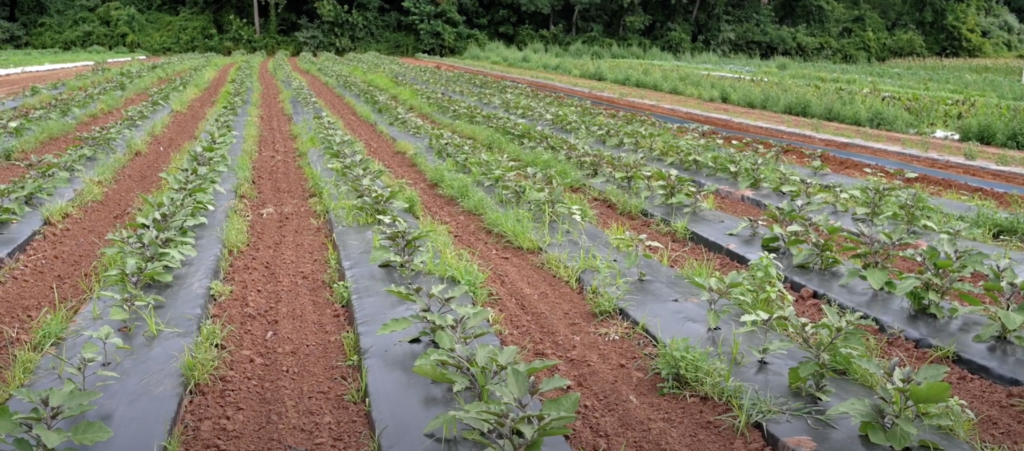During the growing and harvest seasons, vegetable producers often begin their day before sunrise and finish as the last light is seeping into the horizon. These long days are normal but varied. Challenges such as pests, disease, climate change, and weather make each day and each growing season unique and unpredictable.
Vegetable farmers control some of the variables they face – like weeds and the temperature and moisture levels of their soil – by using a product that comes with pros and cons: plastic mulch.
Shuresh Ghimire, assistant extension educator for vegetable crops in the College of Agriculture, Health and Natural Resources (CAHNR), is working with producers in the state to find alternatives to plastic mulch without eliminating the benefits it brings.
“Farmers are among the first to feel the effects of climate change. A successful crop, especially outdoors, is heavily based on climate variables like temperature and precipitation. Farmers need a solution, but we know we can do better than traditional plastic mulch,” says Ghimire.

He is leading efforts to introduce more biodegradable plastic mulch for Connecticut’s vegetable producers.
“The goal is to address these challenges and increase food production closer to home,” says Ghimire. “This provides greater food security and lessens our dependence on traditional agricultural regions like California that are facing their own climate-related challenges.”
Why is mulch necessary? Mulch reduces the need for herbicides, conserves soil moisture, moderates soil temperature, and can increase both crop yield and quality. This helps keep more profits in the growers’ pockets when margins are tight.
However, there are negatives that come with plastic mulch. Most plastic mulch products are non-recyclable. Ongoing research highlights the negative environmental impacts of plastic mulch. It is also costly and labor-intensive for producers to remove at the end of the growing season.
These drawbacks have a big impact at the state and national levels. Connecticut has over 5,500 farms, including about 1,000 that produce vegetables on more than 9,000 acres. There are about 4.4 million acres used for vegetable production in the United States, roughly the size of Connecticut and Rhode Island combined. Plastic mulch becomes an unwieldy annual problem at this scale when it goes to a landfill at the end of each growing season.
Biodegradable plastic mulch was introduced as a solution in the 1990s. Today, it’s an environmentally friendly and sustainable alternative to regular plastic mulch.
Biodegradable plastic mulch is plowed into the ground at the end of the growing season. This eliminates the recycling, environmental, and labor issues of traditional plastic mulch. The biodegradable mulch is applied at the same rate as the traditional plastic mulch, although slightly more loosely. At the end of the season, producers simply till the crops and biodegradable mulch into the soil, then plant their cover crop.
This is the biggest return on investment when switching to this innovative mulch, since it requires far less labor and eliminates removal costs. Composting and biodegradability tests ensure the biodegradable mulch used in vegetable production meets required environmental parameters. It must be 90% biodegraded into carbon and water within two years of plowing into the soil. The remaining 10% is microbial biomass, bacteria and fungi that help decompose organic matter into the soil.
Ghimire is currently conducting research trials on biodegradable plastic mulch in Connecticut and with national collaborators. This work has shown that biodegradable mulch and other forms of environmentally friendly mulching help with vegetable production because they modify the microclimate. This helps with crop growth and addresses climate change issues.
Ghimire is also conducting field trials to evaluate different aspects of biodegradable mulch use. One trial will evaluate the effect of biodegradable mulch on different crops, including tomatoes, since there is concern that their skin will adhere to the biodegradable mulch. His team is also studying long-term soil health after using biodegradable mulch.
After first being introduced to biodegradable mulch five years ago, Steve Bengtson has expanded his farm’s use of the product. Bengtson owns Cold Spring Brook Farm in Berlin, where he grows a variety of vegetable crops.
“Cleanup at the end of the year with traditional plastic mulch involves mowing all the crops down, loosening the edges of the plastic, and pulling it up. A lot of the time the plastic is wet and there are weeds all over the place, making it hard to remove. Using biodegradable mulch, you just remove the irrigation drip line and harrow it in. I recommend people try it on their farm with different crops. That’s how we did it,” Bengtson says.
Organic vegetable production currently cannot use biodegradable mulch, although research is ongoing to determine acceptability in that setting.
Connecticut crops grown with biodegradable mulch include sweet corn, eggplant, pepper, summer squash, broccoli, Brussels sprouts, and greens. Research on melons and other crops that sit on the mulch may follow if the results from Ghimire’s tomato studies show promise. Organic vegetable production currently cannot use biodegradable mulch, although research is ongoing to determine acceptability in that setting.
“Biodegradable plastic mulch enhances vegetable crop quality, saves time for agricultural producers, and reduces labor costs,” says Ghimire. “It’s one of many climate-smart innovations helping agricultural producers adapt and increase resilience while ensuring a safe and abundant food supply locally, regionally, and globally.”
Agricultural producers can use these questions and answers from Ghimire to determine if biodegradable plastic mulch is right for their operation. Support for this work was provided by the Linda Brughelli Fund for Excellence in Extension Services. Brughelli is a parent of a member of the class of ’06.
Follow UConn CAHNR on social media


